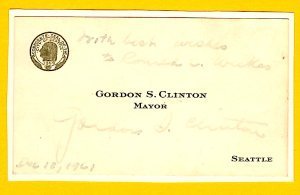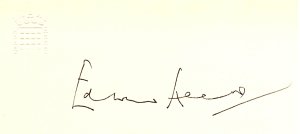Our inaugural bulletin. My journey into philography, more commonly known as autograph collecting, began in 1961. It started with the gift of a signed business card of the Mayor of Seattle. A family friend, City Councilman Wing Luke, obtained the card for me. Soon thereafter I received from him the autograph of President Kennedy. I was hooked.
My first autograph, 1961, the Mayor of Seattle (click to enlarge)
This semi-occasional blog is dedicated to my friend, the late Wing Luke. He was the first Asian-American elected to public office on the westcoast. Luke died tragically in a plane crash at the age of 40. Had he lived, I might have had the privilege of addressing him as Governor Luke. You are invited to visit the Wing Luke Asian Museum online and listen to a short presentation on this great man. Mr. Luke had a tremendous impact upon me. www.wingluke.org/about-us/
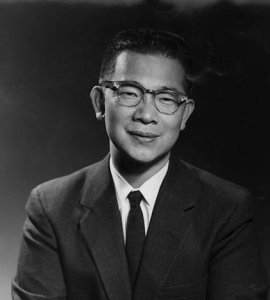
For over four decades it has been my privilege to meet and learn from many reputable, knowledgeable autograph dealers. I have formed lasting friendships with clients and fellow collectors. All things considered, it has been a tremendously rewarding experience to collect autographs. When speaking with parents and young people, I do not hesitate to recommend autograph collecting for its many rewards, the least of which is learning how to construct a letter (a dying art form to be sure).
Along the way, I’ve learned many lessons about autographs – all instructive, some painful. It took me years to learn about forgeries, autograph collecting trends and how to properly conserve autographs. As more and more collectors turn to autographs as a hobby, or even form of investment, it occurred to me that I might share some of my experiences with other collectors. Out of this quest – to educate and advance the hobby – this little blog has been launched. In subsequent issues I hope to touch upon, among other topics: paper and inks, market trends and values, collection preservation, forgeries, and weave a tale or two. If you have a collecting anecdote please share it with me. Your comments are always welcome and much appreciated.
Forgeries and secretarial signatures. This material floods the marketplace. Buyer beware. Did you know that in the late 1920’s, most photographs and letters of Albert Schweitzer were signed by his longtime secretary? The same may be said for US presidential material from Eisenhower forward. It has even been alleged that executive orders and proclamations have been signed with the mechanical Autopen. JFK employed 14 secretaries to sign for him and inscription templates were designed to personalize photographs.
John F. Kennedy – a White House litho-print card (click to enlarge)
Eisenhower – WWII secretarial signature while Chief of Staff (click to enlarge)
FDR – secretarial card signed as NY governor (click to enlarge)
Detecting the Bogus from the Genuine. Most dealers tend to limit their specialization to one or two areas and avoid those in which they have little or no experience. Knowledgeable dealers examine handwriting, (some are schooled in graphoanalysis – the science of handwriting); they look at ink, paper used, watermarks, typography, and compare known (proven) examples of similar material. They also keep abreast of the market and problem areas such as replevin.
Recently, as an example, we obtained what was alleged to be a postcard handwritten and signed by the late Pope John Paul II in 1980 during a visit to Germany. After consultation with several experts familiar with the handwriting of the saintly pontiff, it was revealed that the “autographed postcard” was, in fact, a poor forgery. Apart from the structure of the handwriting, was the use of a broad-nibbed italic pen (such an instrument was never used by the pope).
Prime Minister Edward Heath (autopen 1978) (click to enlarge)
One problem area for the untrained eye is litho-print material. It appears on documents and photographs. Unless it is examined under intense magnification, it is not readily apparent that it is printed rather than authentically-signed. Two examples are (left to right) the Charles DeGaulle card bearing what appears to be a genuine handwritten message. It lacks a salutation and date and, under magnification, the ink is “flat” a red flag of print rather than genuine handwriting. To the right, a postcard bearing what appears to be a note written and signed by the late Ildefonso Cardinal Schuster of Milan. The postcard to the right fooled an Italian dealer. To the knowledgeable dealer, it readily apparent that the lengthy message to the left is a print from an original. The postcard is addressed and dated in another hand.
Finally, a word about secretarial signatures. They abound for celebrities in most fields (Hollywood being at the top of the list). It is widely known among dealers that nearly 95% of all autograph mail requests to the late Sammy Davis, Jr. were secretarial, although he was an accommodating signer in-person. One helpful online reference site is www.isitreal.com, created by German dealer Markus Brandes.
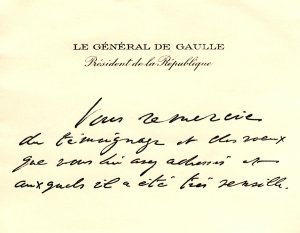
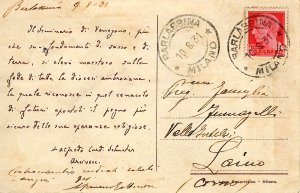
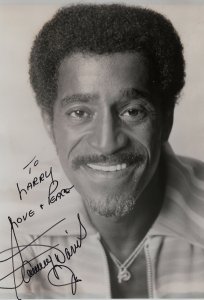
Collectors are urged to study the market. Become familiar with the area of your collecting interest. Research is available online and in many library reference works. Several autograph dealers have published excellent reference books, many of which now are out of print but may be found through booksellers. Among these are: From the President’s PenMovie Star Autographs of the Golden Era, 1930-60; (Susan and Steven Raab, 1994, privately published); 1001 Vintage Hollywood Autographs by William and Yolanda Butts, Main Street Fine Books (privately published) and Profiles In History, Catalogue 23, a spiral bound reference work, that offers an outstanding assemblage of Hollywood autograph examples.

Bette Davis – secretarial signature
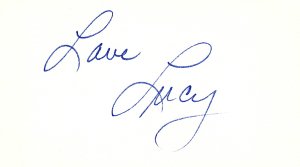
Lucille Ball – a common secretarial signature
Other recommended reading. Esteemed dealer Ken Rendell authored an informative book: History Comes to Life: Collecting Historical Letters and Documents; University of Oklahoma Press, 1995. In 1977 the Pierpont Morgan Library published a trade paperback: American Literary Autographs: from Washington Irving to Henry James. Finally, the late dealer and author Thomas F. Madigan published a highly entertaining book: Word Shadows of the Great: the Lure of Autograph Collecting; Frederick A. Stokes Publishing Co., 1930. If it can even be found, author-signed copies of this work command several hundred dollars. Many dealers such as David Lowenherz, Joseph Rubinfine, Kenneth Rendell and others publish the occasional catalogue. These are excellent references.
Author Sheila Lowe, (MetroBooks 2001) offers a fascinating work on handwriting styles and analysis of the world’s famous in Handwriting of the Famous and Infamous.
Some Conservation Tips. Whether you buy autographs from a dealer or at auction, many come with pencil and other notations on them. Some are from previous owners or dealers. Markings may include prices, dates and details of provenance. Unless these markings greatly detract from the autograph, they should not be removed. If written in pencil, make a photocopy first BEFORE you erase the notations. This information often proves helpful for appraisal and authentication, and provenance is a factor in value.
Document Protectors. Unless the manufacturer states “archival safe” or the folders are made of Mylar (polyester) never store autographs and photographs in sleeves. We have come across many rare autographs that have been irreparably damaged. Over time, chemical compounds in the plastic can erode and breakdown transferring residue to autographs. Autographs should also be stored flat or in reinforced folders to safeguard against wrinkling and other damage. Sunlight can wreck havoc on autographs and silver-gelatin photographs. If your autographs are matted and framed, hang them on inner walls, away from direct sunlight and any heat source. It is wise to occasionally rotate autographs on display so that they are not continuously subjected to sunlight. More valuable matted and framed autographs should be protected behind Plexiglas UF-3 or tinted conservation glass.
Showbiz and Entertainment. This continues to be a popular area of collecting. Costumes, movie props, vintage posters and signed photographs can command high prices at auction. Take the Beatles. Individual autographs run $1,500 for John, $2,000 for Paul, $600 for George and $400-700 for Ringo. If, on the other hand, you have a photograph, album leaf or record jacket signed by the Fab Four, the price can soar to over $15,000. Again, buyer beware. The more popular the celebrity, the greater the chance of forgery. Celebrities known solely by their last name are always highly sought by collectors: Garbo, Gable, Monroe, Hepburn, Bogart. One should expect to pay a premium for authentic material of these showbiz legends.
Celebrated Autograph Collectors. Composer Jerome Kern was an avid collector and amassed a magnificent collection in his lifetime. Other famous collections include President Kennedy, Malcolm Forbes, Franklin D. Roosevelt. The late George W. Cardinal Mundelein, longtime archbishop of Chicago, was a collector of documents and letters of popes and saints. He left an impressive collection to St. Mary of the Lake Seminary in Mundelein, Illinois. Sci-fi author Ray Bradbury was named Collector of the Year in 2003 by the Universal Autograph Collector’s Club. The Chicago hotel retailer, Marshall Field, also collected autographs. Be on the alert. One of his ne’do well nephews decided to enhance his fortune by placing forged autographs in books owned by his uncle! More recently, NYC aspiring authoress Lee Israel forged over 1,000 letters of contemporary literary greats between 1990-2000. Eventually her greed led to exposure. She had the temerity to publish a book on her exploits (more later).
Your handwriting is beautiful, but I can’t read a word of it. Someone once told me that upon receiving a rare, handwritten letter. Maybe I was in a hurry, ill mood, or just careless. Fact is that the letter probably was lost on the lucky recipient who just gave up trying to decipher my scribbling. The good Holy Names nuns who tried to make me to conform to the Palmerian handwriting method exhibited angelic patience.
We baby boomers remember well the handwriting classes we had to endure in elementary school. I’m old enough to remember wooden desks and inkwells although, by then, we had progressed to pencils. Quill pens may be long gone but I still collect and use fountain pens and quality stationery. That might, in part, explain the fascination with autographs!
Today, with “advances” in technology, handwriting has almost become a lost art form. Handwritten letters and cards have been replaced by e-mail, Facebook, Twitter and other forms of social media. One can even subscribe to online services that feature e-notecard and stationery templates (www.paperlesspost.com).
The Common Core State Standards, established in 2010 to guide education curricula, require that schools teach penmanship only in kindergarten and first grade – after that, the focus shifts to typing. Writing by hand helps children improve letter recognition, which is the strongest predictor of reading success so says Karin James, Ph.D. a psychologist with Indiana University.
We’re traveling down a slippery slope to handwriting oblivion. Last year, I sent a small gift to a niece. I fully expected her to write a thank you note (silly me). When I goaded her over her lack of courtesy, she promised to write a note. Fast forward several months. “I couldn’t find a stamp for the envelope.” Then came the best excuse of all: “I don’t have a car and there is no mailbox nearby.” Imagine her surprise when I told her she could just walk the note to the mailbox in her front yard. It would be picked up by the postman. She was clueless.
The Wall Street Journal recently published a terrific article (September 6-7, 2014 “Gear and Gadgets”). Entitled “Don’t Forget (How) to Write: no worries if your handwriting skills have atrophied in the age of keyboards and touch screens. A few time-honored, legibility-enhancing tools can help.” The article focused mainly on the selection of writing instrument best suited to improve your handwriting. It really didn’t address the root issue: our motivation to even pick up a pen and handwrite something other than a grocery list or Post-It reminder.
Contrary to anything people may say, there is a special thrill in finding a letter or handwritten card in the mailbox (the onslaught of holiday mail notwithstanding). A handwritten anything tells your recipient that you cared enough to take time to share your thoughts, kind words, sympathy or encouragement. On the thruway of communication, handwritten messages speed past the competition in how they impact others.
Post-script: Writing in the 9/21/2014 issue of Parade Magazine, (the Sunday newspaper insert) author Melinda Wenner Moyer observes that studies have found that adults write better and longer prose when they are faster at writing by hand. And we may process what we write by hand more deeply. A 2014 study reported that college students who took longhand notes answered conceptual questions about the material better than students who had typed their notes – meaning that, at least in some ways, students may be better off with a composition pad than a keyboard.
Recommended reading: The Missing Ink: the Lost Art of Handwriting; Philip Hensher, 2013.
UNITED STATES PRESIDENTS – Some thoughts
Collecting autographs of US presidents is a landscape fraught with land mines. Our rule of thumb: unless the presidential autograph was acquired in-person — (through some special access or luck of the draw) – assume the signature is secretarial, a clever litho-print, reproduced by autopen or even a forgery.
Within the past 20 years, obtaining an authentic presidential autograph has been challenging. It boils down to access, influence, and whether or not you contributed to a presidential campaign as a volunteer or donor. An in-person autograph might be acquired at a book signing or being near a president, as he exits a TV studio, restaurant or other public venue.
Seeking contemporary autographs by writing to The White House is a crapshoot. Your odds are better at a casino. It is widely known that President Barack Obama is handed a few letters each day or week, selected by his staff, that he answers in person. Keep in mind that The White House receives more than 10,000 letters a day. Nearly 99.9% of all White House letters are signed by a variety of Autopen templates.
Again, there is the rare exception. “41” as George H.W. Bush was often called, was a phenomenal letter-writer, back to his days as vice president. While president, he favored note cards bearing the gold presidential seal that measured 4”x4”. He also was known to self-type some of his correspondence. It was my privilege to correspond with President Bush for many years. In the early 1990s I receive a charming letter from him written from his Kennebunkport summer home. The note was typewritten but, in another type-font, his secretary noted that the President had “self-typed” the note. Again, these are rare exceptions. Today one can buy Bush 41 presidential notes for $300-400 at auction, again depending upon content.
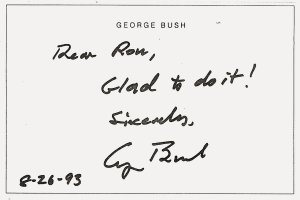
Prior to Eisenhower, (with the introduction of the autopen) it was much easier to obtain a presidential autograph. This certainly was the case with FDR, Truman, Hoover, Coolidge, Harding and other chief executives of the 20th century in the form of signed White House cards, photographs and letters. Such items are not necessarily considered “rare,” but it really depends upon content. Want a really rare collectible? Consider presidential-endorsed payroll checks.
Presidents of the 18th and 19th century are more readily available while autographs of Washington, Jefferson and Lincoln are highly collected and prices reflect their popularity. Caveat: the more important the president, the greater the odds that it is a forgery.
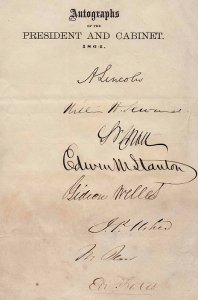
Acquired in-person, Great Sanitary Fair, Philadelphia 1864
Every so often bound volumes of presidential autographs appear on the auction market. As you might imagine, these command prices in the thousands of dollars. A few years ago such an album, circa 1915, custom-bound in leather with the presidential seal, sold at auction for $45,000. If you have deep pockets this might be a good source of early autographs.
If you’re going to collect presidential autographs, do your homework. Establish a relationship with a dealer you trust. Read as many reference books as possible. Become familiar with the signing habits of presidents and the myriad of autopen templates that have been published, as well as secretarial examples. A few books you might enjoy (most of them are out of print but sometimes available on Amazon): The Robot That Helped To Make A President – Charles Hamilton – 1995 – (one is being sold on Amazon for $430); From the President’s Pen: An Illustrated Guide to Presidential Autographs – Michael Minor and Larry Vrzalik – 1991 State House Press, TX.; In the Presence of History: The Authoritative Guide to Historical Autographs for Collectors, History Enthusiasts and Collectors – Steven Raab – 2009 Diamond Press.
It is less common for today’s collector to rub shoulders with the famous, access being the greatest challenge. Most contemporary collectors acquire autographs from dealers, by mail, at trade shows or from eBay and other internet outlets. Those of my generation were fortunate to occasionally gain access to celebrities, security being less a consideration.
A few of my cherished memories include making it all the way to the hotel door where President Kennedy was staying in 1960 (the Olympic Hotel, Seattle). Feet from his open door, I was stopped by an FBI agent who took my letter request and promptly escorted me back to the elevator.
From 1969-75 I served in the US Army for as a senior enlisted chaplain’s assistant and military school instructor. Shortly before my deployment to Vietnam in 1970, I made a one-week private retreat at the great Inisfada manor estate on Manhasset, Long Island (sadly it was demolished in 2013). While there I met the former president of Fordham University, Father Robert Gannon, author of a definitive biography of Francis Cardinal Spellman. He graciously regaled me with many stories over a two hour period, some of which cannot be repeated.
In the early 1970’s I met and came to know the late composer Clark Gesner (Broadway musical genius). I’ll never forget sharing a piano bench with him in his Brooklyn Heights apartment as he played the score from You’re A Good Man, Charlie Brown. Clark also was a die-hard autograph collector and left an impressive amount of material that found its way into the marketplace last year.
Around the same time, I had a brief meeting with the saintly Terence Cardinal Cooke, archbishop of New York, who presented me with a bronze medallion and handsome signed card. I nearly missed because of Manhattan traffic jams.
Perhaps my most memorable brush with celebrity was a two-hour interview in 1983 with the late comedian Phyllis Diller. “Killer Diller” and I continued to correspond until her death in 2013. In our online gallery you will find a lengthy transcript of one of my meetings with Phyllis.
Along the way I met many other greats such as Joan Rivers, Lily Tomlin, Judy Collins, the Pointer Sisters, Liberace, Johnny Mathis, Anne Murray and Bette Midler. There was also a brief encounter with singer Marvin Gaye just a few weeks before his tragic death.
While working in healthcare public relations, I had the pleasure of coordinating a two-day visit to our facility by the master of prestidigitation, David Copperfield, with his “Project Magic.” Mine has been a life filled with many wonderful encounters made possible owing mainly to an interest in autographs.
Perhaps my greatest privilege is the opportunity to meet many of our clients with whom we have collaborated since 1973. One such collector is Monsignor Francis Seymour, archive-emeritus of the Archdiocese of Newark and long-time archivist with Seton Hall University. The good Monsignor has been a client and friend since 1972. In addition to his interest in autographs of prelates, Frank also has devoted decades to acquiring memorial (death) cards for every American bishop and cardinal. He has amassed an impressive collection of cards, some of them quite rare given their limited print run. These cards were usually distributed only at funeral masses.
Last summer, it was my privilege to attend the golden anniversary celebration of Monsignor Seymour’s ordination to the priesthood. Nearly 600 clergy and laity attended the celebratory mass and dinner.
At the same event, I also had the pleasure of meeting another long-time client, Dr. Ronald Rainey of New York University. Doctor Rainey has one of the largest collections of autographs of American and European cardinals. He also was the subject of a feature article in The New Yorker Magazine (“Ecclesiastica” December 10, 1990).
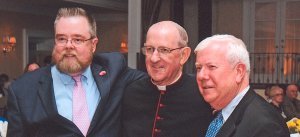
50th priestly anniversary Francis R. Seymour
(L to R: Ron Weekes, Msgr. Seymour, Dr. Ronald Rainey)
Although published some 13 years ago, Margaret Shepherd’s The Art of the Handwritten Note: A Guide to Reclaiming Civilized Communication, continues to offer helpful advice to devotees of handwriting. Observes Shepherd A handwritten note is like dining by candlelight instead of flicking on the lights, like making a gift instead of ordering a product, like taking a walk instead of driving. Handwritten notes will add a lot to your life. You can still use the telephone or the web for the daily chores of staying in touch but, for the words that matter, it’s courteous, classy, caring, and civilized to pick up a pen.
We couldn’t say it any better Margaret!
SEE BOOKS
It’s a well-known fact among seasoned collectors of vintage Hollywood that, despite his brilliant wit, idiosyncratic pantomines and rapid-fire novelty songs, DANNY KAYE was not a fan of autograph collectors. There are stories of Kaye walkikng away from collectors or, when approached during meals or other personal events, launching into a tirade. You didn’t want to incur his wrath.
As a result, authentically-signed material of Danny Kaye is rather uncommon and desirable. One should expect to pay a premium for a signature, letter or signed photograph. Pictured here is a 5″x7″ black and white image which APPEARS to be signed in a blue marker pen by Kaye. It is a very cleverly reproduced signature as part of the printing process which lends credibility to it being genuine. It is not. The signature is flat, no variation in ink flow and, curses, it is an exact replica of two other similar signed photos of Kaye that we have seen — the signature in the same position and angle. Caveat emptor – know what you are collecting and buy from a reputable dealer who offers a money back guarantee.




